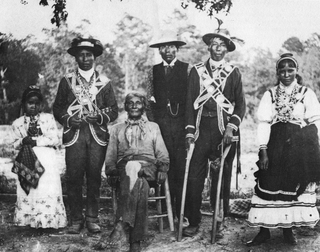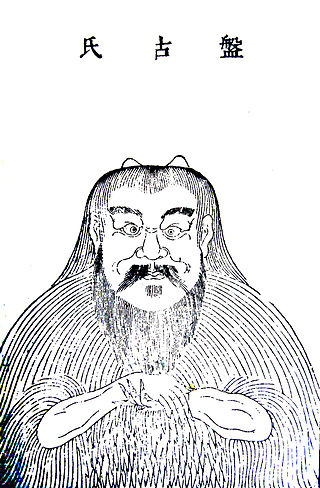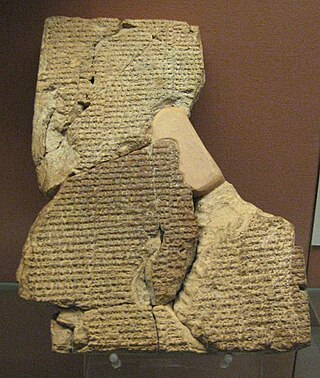
Choctaw mythology is part of the culture of the Choctaw, a Native American tribe originally occupying a large territory in the present-day Southeastern United States: much of the states of Mississippi, Alabama, and Louisiana. In the 19th century, the Choctaw were known to European Americans as one of the "Five Civilized Tribes" even though controversy surrounds their removal.

Cherokee spiritual beliefs are held in common among the Cherokee people – Native American peoples who are indigenous to the Southeastern Woodlands, and today live primarily in communities in North Carolina, and Oklahoma. Some of the beliefs, and the stories and songs in which they have been preserved, exist in slightly different forms in the different communities in which they have been preserved. But for the most part, they still form a unified system of theology.

Mythology of the Iroquois includes the creation stories and folktales of the Native Americans who formed the confederacy of the Five Nations, later the Six Nations. Historically, these stories were recorded in wampum and recited, only being written down later. In the written versions, the spellings of names differ due to transliteration and spelling variations in European languages that were not yet standardized. Variants of the stories exist, reflecting different localities and times.
Lenape mythology is the mythology of the Lenape people, an Indigenous peoples of the Northeastern Woodlands
The Abenaki people are an indigenous peoples of the Americas located in the Northeastern Woodlands region. Their religious beliefs are part of the Midewiwin tradition, with ceremonies led by medicine keepers, called Medeoulin or Mdawinno.

The indigenous peoples of the Americas comprise numerous different cultures. Each has its own mythologies. Some are quite distinct, but certain themes are shared across the cultural boundaries.

Pangu is a primordial being and creation figure in Chinese mythology who separated heaven and earth and became geographic features such as mountains and rivers.
In the context of creation myths, the term Five Suns describes the doctrine of the Aztec and other Nahua peoples in which the present world was preceded by four other cycles of creation and destruction. It is primarily derived from the mythological, cosmological and eschatological beliefs and traditions of earlier cultures from central Mexico and the Mesoamerican region in general, and fits into a broader category of Fifth World mythologies. The Late Postclassic Aztec society inherited many traditions concerning Mesoamerican creation accounts, while modifying some aspects and supplying novel interpretations of their own. In the creation myths which were known to the Aztec and other Nahua peoples of the Late Postclassic era, the central tenet was that there had been four worlds, or "Suns," before the present universe. These earlier worlds and their inhabitants had been created, then destroyed by the catastrophic action of leading deity figures. The present world is the fifth sun, and the Aztec saw themselves as "the People of the Sun," whose divine duty was to wage cosmic war in order to provide the sun with his tlaxcaltiliztli ("nourishment"). Without it, the sun would disappear from the heavens. Thus the welfare and the very survival of the universe depended upon the offerings of blood and hearts to the sun.

Philippine mythology is the body of stories and epics originating from, and part of, the indigenous Philippine folk religions, which include various ethnic faiths distinct from one another. Philippine mythology is incorporated from various sources, having similarities with Indonesian and Malay myths, as well as Hindu, Muslim, Shinto, Buddhist, and Christian traditions, such as the notion of heaven, hell, and the human soul. Philippine mythology attempts to explain the nature of the world through the lives and actions of heroes, deities, and mythological creatures. The majority of these myths were passed on through oral tradition, and preserved through the aid of community spiritual leaders or shamans and community elders.
The Fifth World in the context of creation myths describes the present world as interpreted by several indigenous groups in the USA and Central America. The central theme of the myth holds that there were four other cycles of creation and destruction that preceded the Fifth World. The creation story is taken largely from the mythological, cosmological, and eschatological beliefs and traditions of earlier Mesoamerican cultures.
The Epic of Darkness is a collection of tales and legends of primeval China in epic poetry, preserved by the inhabitants of the Shennongjia mountain area in Hubei. It is composed of numerous Chinese myths relating to the creation of the world, containing accounts from the birth of Pangu till the historical era. It dates back to the Tang Dynasty of China. It was translated and published by Hu Chongjun after the discovery of a manuscript in 1982.

Melanesian mythology refers to the folklore, myths, and religions of Melanesia, a region in Southwest Oceania that encompasses the archipelagos of New Guinea, the Torres Strait Islands, Solomon Islands, Vanuatu, New Caledonia and Fiji.

Ut-napishtim or Uta-na’ishtim, Atra-Hasis, Ziusudra (Sumerian), Xisuthros is a character in ancient Mesopotamian mythology. He is tasked by the god Enki to create a giant ship to be called Preserver of Life in preparation of a giant flood that would wipe out all life. The character appears in the Epic of Gilgamesh and is recognized as the inspiration for Noah in the Book of Genesis.
Chinese creation myths are symbolic narratives about the origins of the universe, earth, and life. In Chinese mythology, the term "cosmogonic myth" or "origin myth" is more accurate than "creation myth", since very few stories involve a creator deity or divine will. Chinese creation myths fundamentally differ from monotheistic traditions with one authorized version, such as the Judeo-Christian Genesis creation narrative: Chinese classics record numerous and contradictory origin myths. Traditionally, the world was created on Chinese New Year and the animals, people, and many deities were created during its 15 days.

The mythology of the Miwok Native Americans are myths of their world order, their creation stories and 'how things came to be' created. Miwok myths suggest their spiritual and philosophical world view. In several different creation stories collected from Miwok people, Coyote was seen as their ancestor and creator god, sometimes with the help of other animals, forming the earth and making people out of humble materials like feathers or twigs.

Jewish mythology is the body of myths associated with Judaism. Elements of Jewish mythology have had a profound influence on Christian mythology and on Islamic mythology, as well as on world culture in general. Christian mythology directly inherited many of the narratives from the Jewish people, sharing in common the narratives from the Old Testament. Islamic mythology also shares many of the same stories; for instance, a creation-account spaced out over six periods, the legend of Abraham, the stories of Moses and the Israelites, and many more.

Turtle Island is a name for Earth or North America, used by some Indigenous peoples, as well as by some Indigenous rights activists. The name is based on a common North American Indigenous creation story and is in some cultures synonymous with "North America."
There are a vast array of myths surrounding the Blackfoot Native Americans as well as Aboriginal people. The Blackfeet inhabit the Great Plains, in the areas known as Alberta, Saskatchewan, and areas of Montana. These stories, myths, origins, and legends play a big role in their everyday life, such as their religion, their history, and their beliefs. Only the elders of the Blackfoot tribes are allowed to tell the tales, and are typically difficult to obtain because the elders of the tribes are often reluctant to tell them to strangers who are not of the tribe. People such as George B. Grinnell, John Maclean, D.C. Duvall, Clark Wissler, and James Willard Schultz were able to obtain and record a number of the stories that are told by the tribes.
The Slavic creation myth is a cosmogonic myth in Slavic mythology that explains how the world was created, who created it, and what principles guide it. This myth, in its Christianized form, survived until the nineteenth and twentieth century in various parts of the Slavdom in chronicles or folklore. In the Slavic mythology there are three versions of this myth: the first version is the so-called earth-diver myth, which intertwines two main motifs: the dualistic motif – the cooperation of God and the Devil is required to create the world, and the oceanic motif – the pre-existence water, where the seed of the Earth comes from; the second version speaks about the origin of the universe and the world from the Cosmic Egg and the World Tree; the third one about creation from a dismemberment of a primordial being.










